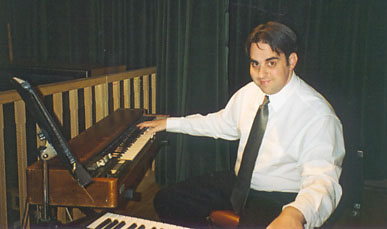

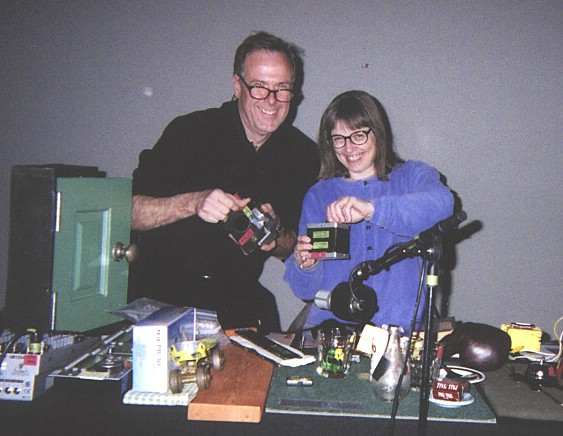
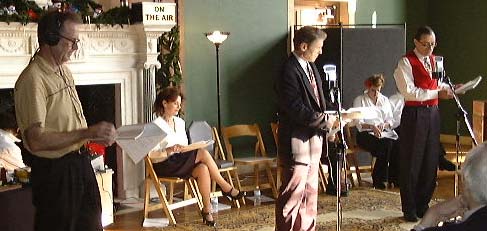
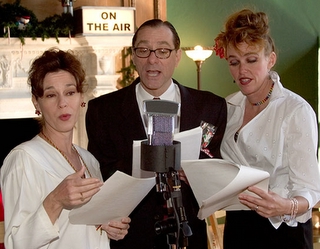

Last updated: July 8, 2023





The SFX artists workbehind a table--STAGE LEFT or STAGE RIGHT—with the actors in the middle and any live musicians on the opposite end of the stage. The SFX should be quite DOWNSTAGE, level with the microphones—so there can be eye contact with the actors, who must often get cues as to when to answer the door or pick up the phone or club someone over the head. My table is usually at a diagonal, facing the actors and the rest of the stage. Eye contact with the live musicians is necessary also as we must always coordinate our cues.
The table is usually a typical 6-ft cafeteria table with a black table cloth—that covers the front end to the floor (thus hiding the SFX gear and extra boxes under the table). I array my devices across the table—with a foam rubber “landing pad” (it’s the yellow pad in the attached photos) to allow me a quiet place to put down guns or coins or knives. My script is held in plastic sheets within a 3 ring binder—this provides for quiet turning of pages, protects scripts from water spills, and allows me to see ahead to where the upcoming SFX cues are.

Behind the table I have a variety of 18” x 18” walking surfaces—wood, raised decks, stairs, cobblestone, marble, or gravel—and carpet between them so I can be quiet when need be. Note my small SFX door and that it has a wooden floor directly in front of it—in shows, doors open and people then walk in or out—so, I put a floor near the door. I do some sound effects UNDER the table as the materials I use to create a sound—say squeezing a Styrofoam egg carton to simulate the sound of a lynching noose tightening around Tonto’s neck—would generate a laugh if the audience saw it, while the actor is portraying being hung. SFX artists performing on stage have to balance getting the right sound with NOT stealing focus from the actors.
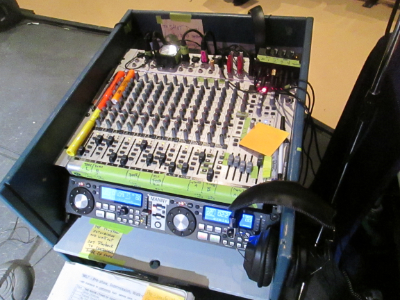
Beside my SFX table is my “sound-truck”—a rolling cart that contains a number of electronic devices: a dual DJ-style MP3 playback device (for music and pre-recorded sounds—usually background ambiences and things too hard to produce manually), a 20 inpute mixer board--with a headphone amp sitting on top. Unseen is a 19"x1" reverb unit. I mix my own SFX mics (three of them—one on a boom over the table, one near the door latch and a third wherever needed.)
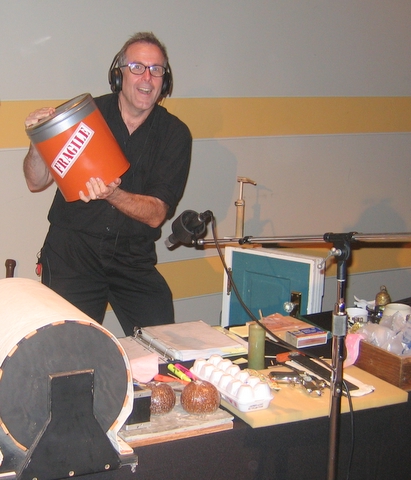
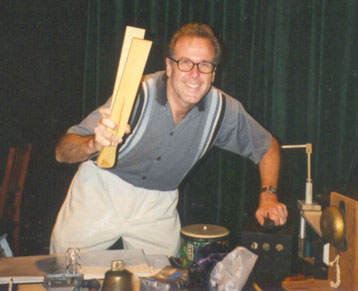
Regarding what I wear while performing: I do both Old Time and Modern radio dramas. For OTR shows, I have vintage looking shirts and pants—lots of sleeves-rolled-up shirts. For modern shows, they often want totally black outfits. I don’t wear a tie, but my mentors—who worked for Jack Benny and Orson Welles often had to wear suits and ties on-stage, but preferred short sleeves and no ties for studio work. (Ties can get in the way of the devices, so I never wear them—not even bow ties.) As in the golden age, the sound effects artists always wear headphones and I have a variety of models that look old and new. Of course, since we have the “cans” on, we don’t wear hats—no matter how 1940s that looks.
Here are other photos from my website that show me using various SFX rigs at various SFX gigs: